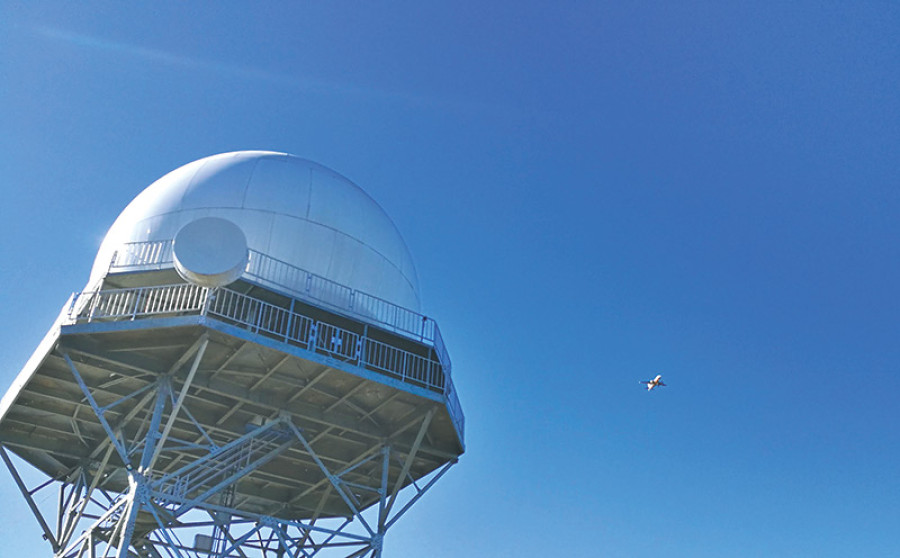Money
Advanced radar system to make Nepal’s skies safer
Nepal’s air traffic control (ATC) can now monitor the country’s entire airspace and keep track of aircraft from the Himalaya to the Indian border using an advanced radar system recently built on a hilltop in Lalitpur.
Sangam Prasain
Nepal’s air traffic control (ATC) can now monitor the country’s entire airspace and keep track of aircraft from the Himalaya to the Indian border using an advanced radar system recently built on a hilltop in Lalitpur.
The Mode S Monopulse Secondary Surveillance Radar (MSSR) installed at Bhatte Danda supersedes the primary and secondary surveillance radar at Kathmandu’s Tribhuvan International Airport (TIA).
This system was installed in 1997 with Japanese aid following two air crashes in 1992 which highlighted the need for modern surveillance systems.
The mishaps in July and September, which occurred in the hills surrounding Kathmandu, involved a Thai Airways flight and a Pakistan International Airlines flight respectively. They killed 280 people altogether.
On Monday, the US Federal Aviation Administration (FAA) completed flight inspection of the new MSSR at Bhatte Danda. Following the successful test, the Civil Aviation Authority of Nepal (Caan) has planned to begin commercial operation of the radar system on February 1.
The sophisticated infrastructure covers almost all of Nepal, including parts of Indian airspace and the entire Himalaya, allowing increased efficiency and safety in areas where radar coverage has so far been limited.
“The MSSR coverage will be extended to the entire eastern, southern and Himalaya regions, and up to Surkhet (250 nautical miles or 463 km) in the west,” said Sanjiv Singh Kathayat, chief of the project.
Flight inspection of the MSSR continued for 20 hours for three consecutive days with a Bombardier Challenger 600 jet. The FAA will submit a detailed report of the inspection within 15 days, and Caan will publish a notice in the Aeronautical Information Publication (AIP), Kathayat said. The AIP published by Caan contains information about the latest air navigation system installed in Nepal. It will take 57 days to complete the process, he said.
As the country’s air traffic has experienced dramatic growth in terms of both
international and domestic flights, the need for greater efficiency and accuracy has been acutely felt, said Kathayat. More than 40 air traffic controllers have received training to operate the new radar system.
Improving Safety
The next generation radar provides improved accuracy and enhanced surveillance, and marks the entry of the latest technology in Nepal’s air traffic control.
According to Kathayat, radar surveillance will increase fivefold after it is switched on for commercial operation on February 1. Almost all air routes across Nepal are visible on the radar system, so it will make the ATC’s job easier, he said.
Likewise, ATCs can accommodate more aircraft on any route at a given time which will reduce airspace congestion, particularly at TIA.
ATCs using the current radar system have to keep a horizontal separation of 10-15 nautical miles (19-28 km) between aircraft approaching TIA. The MSSR system will allow ATCs to reduce the gap between aircraft to 3-5 nautical miles (6-9 km).
In bad weather conditions or in case of a navigation equipment failure in an aircraft, ATCs can provide radar vectoring services. The procedure guides identified aircraft on the radar on the final approach track. The controller instructs the pilot to fly specific headings at appropriate times by maintaining two-way radio communication. Moreover, aircraft violating Nepal’s airspace will also show up on the radar. The radar gives information about flight movements right from landing and take-off to weather conditions, aircraft identity and altitude, among others.
Long-awaited system
TIA currently possesses primary and secondary surveillance radar. The existing system at Kathmandu airport was installed in 1997 under Japanese official development assistance. It was set up at a cost of $34 million.
The Japan government’s grant to modernize TIA came after two major crashes involving Thai Airways and Pakistan International Airlines aircraft. Seventeen high-level Japanese diplomats were killed in the Thai crash.
In 1994, the Japanese government conducted a detailed study of the radar system at TIA and the project was completed in 1997.
The installation of a secondary radar at Bhatte Danda had been proposed in 1994 when the Nepal government approved Japan’s plan to modernize TIA. However, the plan was put on hold due to multiple reasons. “As TIA is situated in a valley surrounded by hills, the coverage of the existing radar does not extend beyond 50 nautical miles (90 km),” said Kathayat, who was among the first batch of engineers trained under the Japanese government project.
The plan to install a sophisticated radar materialized in 2013 when the Japan International Cooperation Agency (Jica) approved a Rs906 million grant for Nepal as part of the broader TIA modernization project.
The MSSR was completed in July 2016 after four years of work. Jica handed over
the project to Caan last September. However, the commissioning of the system was delayed as Caan did not receive a single bidder even after global tenders were issued twice to conduct flight inspection. Subsequently, the FAA showed interest to assist Nepal.




 5.44°C Kathmandu
5.44°C Kathmandu















